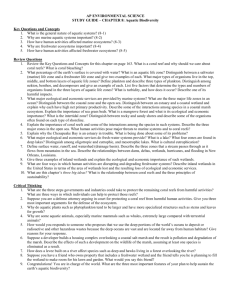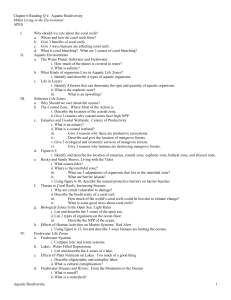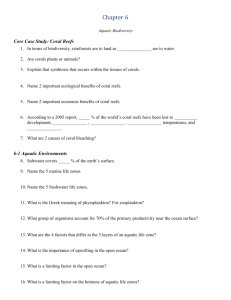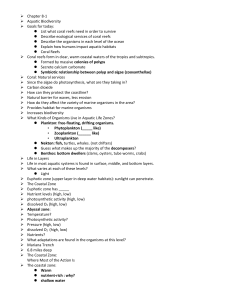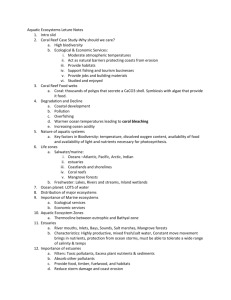Estuaries and coastal wetlands
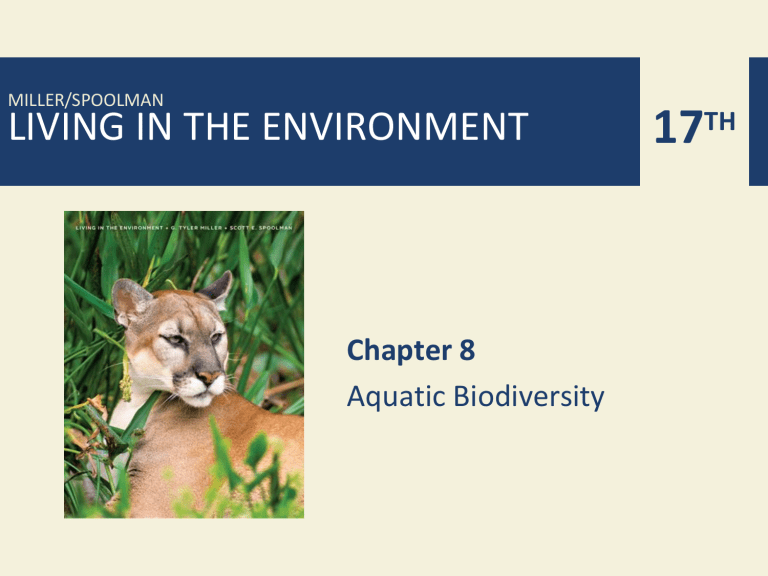
MILLER/SPOOLMAN
LIVING IN THE ENVIRONMENT 17 TH
Chapter 8
Aquatic Biodiversity
Core Case Study: Why Should We Care about Coral Reefs? (1)
• Biodiversity
• Formation
• Tiny animals (polyps) and algae have mutualistic relationship
• Polyps secret calcium carbonate shells, which become coral reefs
Coral Reefs Are Amazing Centers of Biodiversity
• Marine equivalent of tropical rain forests
• Habitats for one-fourth of all marine species
Core Case Study: Why Should We Care about Coral Reefs? (2)
• Important ecological and economic services
• Moderate atmospheric temperatures
• Act as natural barriers protecting coasts from erosion
• Provide habitats
• Support fishing and tourism businesses
• Provide jobs and building materials
• Studied and enjoyed
Core Case Study: Why Should We Care about Coral Reefs? (3)
• Degradation and decline
• Coastal development
• Pollution
• Overfishing
• Warmer ocean temperatures leading to coral bleaching: kill algae and thus the polyps
• Increasing ocean acidity
A Healthy Coral Reef in the Red Sea
Fig. 8-1, p. 168
Where are coral reefs located?
• Tropical and sub-tropical environments, most between 30 N and 30 S latitudes.
Blue Planet Videos
• Blue Planet
• Open Ocean
• The Deep
Estimated Annual Average NPP in Major
Life Zones and Ecosystems
Fig. 3-15, p. 66
Questions
• Why would the npp of estuaries rival that of a tropical rainforest?
• Why would the npp of the continental shelf and open ocean be way lower than that of estuaries?
• Given the low npp of the open ocean, why should we care much about biodiversity there?
8-1 What Is the General Nature of
Aquatic Systems?
• Concept 8-1A Saltwater and freshwater aquatic life zones cover almost three-fourths of the earth ’ s surface, with oceans dominating the planet.
• Concept 8-1B The key factors determining biodiversity in aquatic systems are temperature, dissolved oxygen content, availability of food and availability of light, and nutrients necessary for photosynthesis.
Open Ocean
• The open ocean has low npp on a per m 2 basis
(except in upwelling areas), but because it covers so much (how much?) of the earth’s surface, it makes the largest contribution to overall npp.
Major Ecological and Economic Services Provided by
Marine Systems
Fig. 8-5, p. 172
8-1 What Is the General Nature of
Aquatic Systems?
• Concept 8-1A Saltwater and freshwater aquatic life zones cover almost three-fourths of the earth ’ s surface, with oceans dominating the planet.
• Concept 8-1B The key factors determining biodiversity in aquatic systems are temperature, dissolved oxygen content, availability of food and availability of light, and nutrients necessary for photosynthesis.
Most of the Earth Is Covered with
Water (1)
• Saltwater: global ocean divided into 4 areas
• Atlantic
• Pacific
• Arctic
• Indian
• Freshwater
Most of the Earth Is Covered with
Water (2)
• Aquatic life zones
• Saltwater life zones ( marine life zones )
• Oceans and estuaries
• Coastlands and shorelines
• Coral reefs
• Mangrove forests
• Freshwater life zones
• Lakes
• Rivers and streams
• Inland wetlands
The Ocean Planet
Fig. 8-2, p. 169
Aquatic Systems
Fig. 8-3, p. 170
Most Aquatic Species Live in Top, Middle, or Bottom Layers of Water (1)
• Plankton : free floating
• Phytoplankton
• Primary producers for most aquatic food webs
• Zooplankton
• Primary and secondary consumers
• Single-celled to large invertebrates like jellyfish
• Ultraplankton
• Tiny photosynthetic bacteria
Most Aquatic Species Live in Top, Middle, or Bottom Layers of Water (2)
• Nekton
• Strong swimmers: fish, turtles, whales
• Benthos
• Bottom dwellers: oysters, sea stars, clams, lobsters, crabs
• Decomposers
• Mostly bacteria
Most Aquatic Species Live in Top, Middle, or Bottom Layers of Water (3)
• Key factors in the distribution of organisms
• Temperature
• Dissolved oxygen content
• Availability of food
• Availability of light and nutrients needed for photosynthesis in the euphotic (photic) zone
• Turbidity : degree of cloudiness in water
• Inhibits photosynthesis
Four Types of Aquatic Life Forms
Fig. 8-4, p. 171
8-2 Why Are Marine Aquatic
Systems Important?
• Concept 8-2 Saltwater ecosystems are irreplaceable reservoirs of biodiversity and provide major ecological and economic services.
Oceans Provide Vital Ecological and Economic Resources
• Estimated $12 trillion per year in goods and services
• Reservoirs of diversity in three major life zones
1. Coastal zone
• Warm, nutrient rich, shallow
• Shore to edge of continental shelf
• Usually high NPP from ample sunlight and nutrients
2. Open sea
3. Ocean bottom
Major Ecological and Economic Services Provided by
Marine Systems
Fig. 8-5, p. 172
Major Life Zones and Vertical Zones in an Ocean
Fig. 8-6, p. 173
Estuaries and Coastal Wetlands Are
Highly Productive (1)
• Estuaries and coastal wetlands
• Where rivers meet the sea
• Seawater mixes with freshwater
• Very productive ecosystems: high nutrient levels
• River mouths
• Inlets
• Bays
• Sounds
• Salt marshes
• Mangrove forests
View of an Estuary from Space
Fig. 8-7, p. 173
Coastal Marsh Ecosystem
Fig. 8-8, p. 174
Estuaries and Coastal Wetlands Are
Highly Productive (2)
• Seagrass Beds
• Grow underwater in shallow areas
• Support a variety of marine species
• Stabilize shorelines
• Reduce wave impact
• Mangrove forests
• Along tropical and subtropical coastlines
• 69 different tree species that grow in saltwater
See Grass Bed Organisms
Fig. 8-9, p. 174
Mangrove Forest in Australia
Fig. 8-10, p. 175
Estuaries and Coastal Wetlands Are
Highly Productive (3)
• Important ecological and economic services
• Coastal aquatic systems maintain water quality by filtering
• Toxic pollutants
• Excess plant nutrients
• Sediments
• Absorb other pollutants
• Provide food, timber, fuelwood, and habitats
• Reduce storm damage and coast erosion
Rocky and Sandy Shores Host Different
Types of Organisms
• Intertidal zone
• Rocky shores
• Sandy shores: barrier beaches
• Organism adaptations necessary to deal with daily salinity and moisture changes
• Importance of sand dunes
Rocky Shore Beach
Sea star Hermit crab
Shore crab
High tide
Periwinkle
Sea urchin
Anemone
Mussel
Barrier Beach
Nudibranch
Low tide
Sculpin
Barnacles
Monterey flatworm
Kelp
Sea lettuce
Beach flea
Peanut worm
Tiger beetle
Blue crab
Dwarf olive
Clam
High tide
Silversides
Low tide
Sandpiper
Mole shrimp
Ghost shrimp
White sand macoma
Sand dollar
Moon snail
Stepped Art
Fig. 8-11, p. 176
Coral Reefs Are Amazing Centers of Biodiversity
• Marine equivalent of tropical rain forests
• Habitats for one-fourth of all marine species
Natural Capital: Some Components and Interactions in a
Coral Reef Ecosystem
Fig. 8-12, p. 177
The Open Sea and Ocean Floor Host a
Variety of Species (1)
• Three vertical zones of the open sea
1. Euphotic zone
• Phytoplankton
• Nutrient levels low
• Dissolved oxygen levels high
2. Bathyal zone
• Dimly lit
• Zooplankton and smaller fishes
The Open Sea and Ocean Floor Host a
Variety of Species (2)
3. Abyssal zone
• Dark and cold
• High levels of nutrients
• Little dissolved oxygen
• Deposit feeders
• Filter feeders
• Upwelling brings nutrients to euphotic zone
• Primary productivity and NPP
8-3 How Have Human Activities
Affected Marine Ecosystems?
• Concept 8-3 Human activities threaten aquatic biodiversity and disrupt ecological and economic services provided by saltwater systems.
Human Activities Are Disrupting and
Degrading Marine Systems
• Major threats to marine systems
• Coastal development
• Overfishing
• Use of fishing trawlers
• Runoff of nonpoint source pollution
• Point source pollution
• Habitat destruction
• Introduction of invasive species
• Climate change from human activities
• Pollution of coastal wetlands and estuaries
Natural Capital Degradation
Major Human Impacts on Marine Ecosystems and Coral Reefs
Marine Ecosystems Coral Reefs
Half of coastal wetlands lost to agriculture and urban development
Over one-fifth of mangrove forests lost to agriculture, development, and shrimp farms since 1980
Ocean warming
Rising ocean acidity
Soil erosion
Algae growth from fertilizer runoff
Bleaching
Beaches eroding because of coastal development and rising sea levels
Ocean bottom habitats degraded by dredging and trawler fishing
Rising sea levels
Increased UV exposure
Damage from anchors
At least 20% of coral reefs severely damaged and
25–33% more threatened
Damage from fishing and diving
Fig. 8-13, p. 179
Case Study: The Chesapeake Bay—an
Estuary in Trouble (1)
• Largest estuary in the US; polluted since 1960
• Human population increased
• Point and nonpoint sources raised pollution
• Phosphate and nitrate levels too high
• Excess sediments from runoff and decreased vegetation
Case Study: The Chesapeake Bay—an
Estuary in Trouble (2)
• Oysters, a keystone species, greatly reduced
• 1983: Chesapeake Bay Program
• Integrated coastal management with local, state, federal governments and citizens ’ groups
• 2008 update:
• 25 years and $6 billion
• Program met only 21% of goals
• Water quality “ very poor ”
Chesapeake Bay
Fig. 8-14, p. 180
8-4 Why Are Freshwater Ecosystems
Important?
• Concept 8-4 Freshwater ecosystems provide major ecological and economic services, and are irreplaceable reservoirs of biodiversity.
Water Stands in Some Freshwater
Systems and Flows in Others (1)
• Standing (lentic) bodies of freshwater
• Lakes
• Ponds
• Inland wetlands
• Flowing (lotic) systems of freshwater
• Streams
• Rivers
Water Stands in Some Freshwater
Systems and Flows in Others (2)
• Four zones based on depth and distance from shore
1. Littoral zone
• Near shore where rooted plants grow
• High biodiversity
• Turtles, frogs, crayfish, some fish
2. Limnetic zone
• Open, sunlight area away from shore
• Main photosynthetic zone
• Some larger fish
Water Stands in Some Freshwater
Systems and Flows in Others (3)
3. Profundal zone
• Deep water too dark for photosynthesis
• Low oxygen levels
• Some fish
4. Benthic zone
• Decomposers
• Detritus feeders
• Some fish
• Nourished primarily by dead matter
Major Ecological and Economic Services Provided by
Freshwater Systems
Fig. 8-15, p. 181
Distinct Zones of Life in a Fairly Deep Temperate Zone
Lake
Fig. 8-16, p. 182
Some Lakes Have More Nutrients
Than Others
• Oligotrophic lakes
• Low levels of nutrients and low NPP
• Very clear water
• Eutrophic lakes
• High levels of nutrients and high NPP
• Murky water with high turbidity
• Mesotrophic lakes
• Cultural eutrophication of lakes from human input of nutrients
The Effect of Nutrient Enrichment on a Lake
Fig. 8-17, p. 182
Freshwater Streams and Rivers Carry
Water from the Mountains to the Oceans
• Surface water
• Runoff
• Watershed, drainage basin
• Three aquatic life zones
• Source zone
• Transition zone
• Floodplain zone
Three Zones in the Downhill Flow of Water
Fig. 8-18, p. 183
Case Study: Dams, Deltas, Wetlands,
Hurricanes, and New Orleans
• Coastal deltas, mangrove forests, and coastal wetlands: natural protection against storms
• Dams and levees reduce sediments in deltas: significance?
• New Orleans, Louisiana, and Hurricane Katrina:
August 29, 2005
• Global warming, sea rise, and New Orleans
New Orleans, Louisiana Flooded by Hurricane Katrina
Fig. 8-19, p. 185
Projection of New Orleans if the Sea Level Rises 0.9 Meter
Fig. 8-20, p. 185
Freshwater Inland Wetlands Are
Vital Sponges (1)
• Marshes
• Swamps
• Prairie potholes
• Floodplains
• Arctic tundra in summer
Freshwater Inland Wetlands Are
Vital Sponges (2)
• Provide free ecological and economic services
• Filter and degrade toxic wastes
• Reduce flooding and erosion
• Help to replenish streams and recharge groundwater aquifers
• Biodiversity
• Food and timber
• Recreation areas
8-5 How Have Human Activities
Affected Freshwater Ecosystems?
• Concept 8-5 Human activities threaten biodiversity and disrupt ecological and economic services provided by freshwater lakes, rivers, and wetlands.
Human Activities Are Disrupting and
Degrading Freshwater Systems
• Impact of dams and canals on rivers
• Impact of flood control levees and dikes along rivers
• Impact of pollutants from cities and farms on streams, rivers, and lakes
• Impact of drained wetlands
Current Events Blitz
• At your table, actively read the article your team has been assigned. (10 minutes)
• Develop a 3-minute summary presentation about your article (15 minutes):
• Gist of article
• Where and when article was published.
• Summary
• How does this relate to Chapter 8? (Be specific.)
• Overall potential positives/negatives of project
• Email to me
• Present (12 minutes)
Three Big Ideas
1. Saltwater and freshwater aquatic life zones cover almost three-fourths of the earth ’ s surface, and oceans dominate the planet.
2. The earth ’ s aquatic systems provide important ecological and economic services.
3. Human activities threaten biodiversity and disrupt ecological and economic services provided by aquatic systems.



